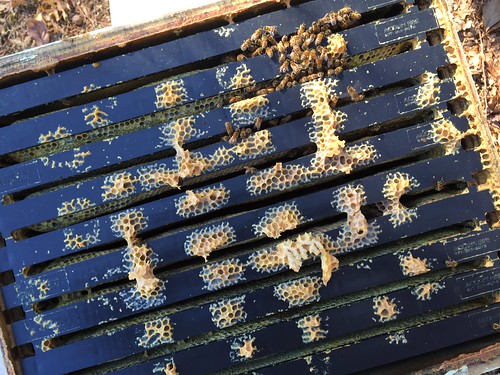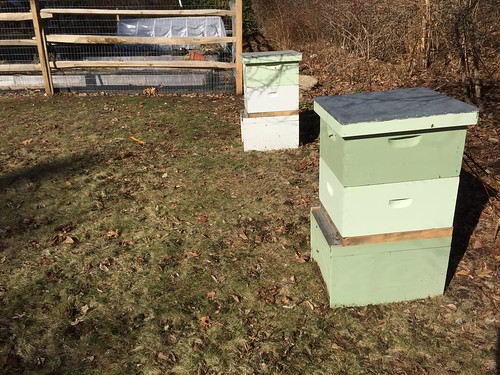I was wondering about my bees today and so I dropped an email to Tony at my local bee club and asked if I should be checking them in the winter. The answer was "Yes, I should". But not like a summer inspection. Tony recommended suiting up, but no smoker. He said to lift hives from the back to check their weight. If light, they've used up their winter honey stores. Finally, he said, lift the cover and check the location of the bees and if they're alive. If they're at the top of the topmost hive, they likely need feeding and should be fed with a winter recipe.
So, the weight of both my hive top boxes is very heavy. That's good. But I was disappointed when I opened the hives. I wish I had seen more bees. Being my first winter, I didn't really know what to expect, but I was hoping to see more. One hive had maybe a baseball-sized cluster, the other maybe a soft-ball. Both clusters were at the top and I couldn't see more than a scattered few bees elsewhere inside the frames using my flashlight. This didn't seem good to me.
While checking them, I became concerned about the hives' location. It was a nice warm day, mid 40's, but the hives were against the woods with a northeast exposure and it was cold there. Snow had melted from most other places, but not here. Around one of the hives, a large puddle had collected on top of ice and there were drowned bees in it. This was the hive with fewer bees in it and this one also had some dysentery on the face. It was probably a hasty decision, but I decided to move the hives to the other side of my yard. I didn't feel I had much to lose because there were so few bees left.
I picked up the top frame and placed it on an inverted trash can. It was all I could do to lift it - my guess at least 60 lbs of honey. The bottom box was light. I moved the base, (a mouse was living on the dirt underneath) and brought it to its new location using a wheelbarrow. Then I moved the bottom box, then the top. I repeated with second hive. I was pleased to get a good amount of bees buzzing around in the process, though it all went fast and smoothly.
The new location has a southwest exposure - it's just to the south of my vegetable garden. It was bright and sunny during the move. The bees hung out on the face of the hives and it seemed to me they enjoyed the sunbath. The afternoon sun had melted all the snow and thawed the top few inches of soil here. I don't think the chilly old location was getting more than an hour of early morning sun.
Nevertheless, I'm not feeling really good about these hives surviving the winter. I think I'll place an order now for a spring package.




